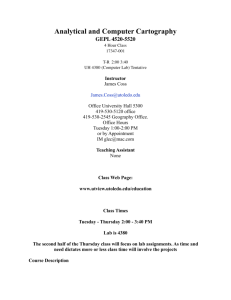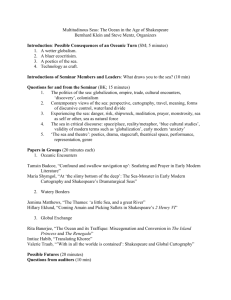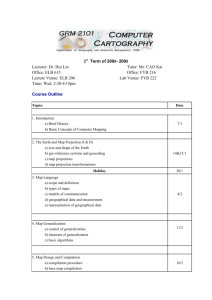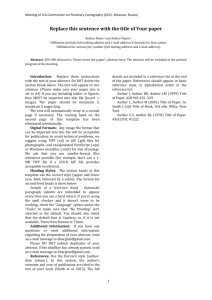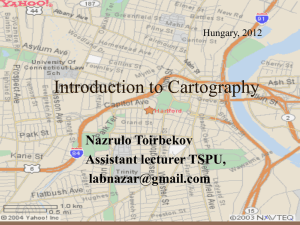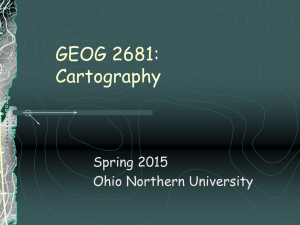Cartography
advertisement
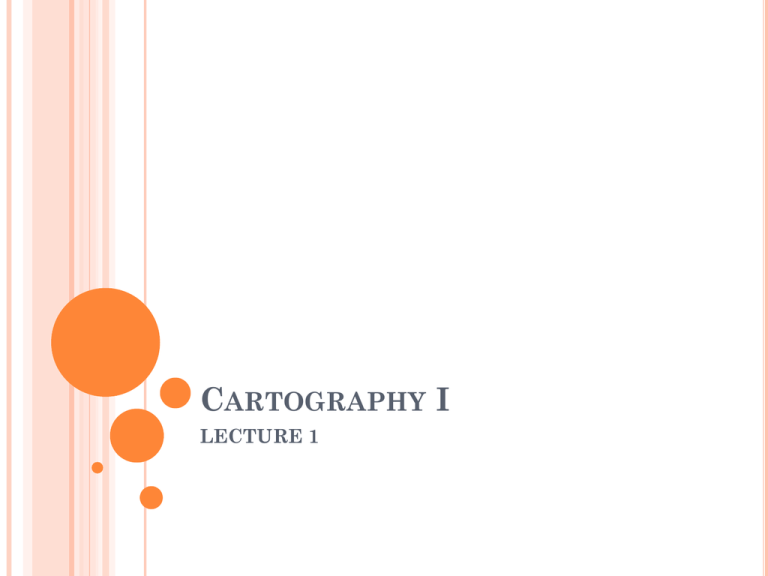
CARTOGRAPHY I LECTURE 1 CARTOGRAPHY I History of Cartography Map Scales and content Symbolisation Introduction to map production Thematic and topographic mapping Generalisation Map layout Relief representation CARTOGRAPHY I- NON-BRIDGE Map projections- Trig+a little math Introduction to survey drawings Basic concepts and types; Basic drafting- construction of grid lines Lettering; plotting- Details(offset and polar methods Longitudinal and cross sections Contouring; preparation of site(cadastral) plans Inking. Use of ArcView Software Practicals- Using ArcView GIS. CARTOGRAPHY CARTOGRAPHY Cartography means ‘the conveying of spatial information by means of maps’ Not only the manufacturing of maps With the advent of computers and GIS(Geographical Information Systems) new definition: ‘the information transfer that is centred about a spatial database which can be considered in itself a multifaceted model of geographic reality’ CARTOGRAPHY Cartography is a branch of graphics Efficient at handling data 2d/3d Manipulation Analysis Display With the advent of computers and cutting edge technology Internet and multi-media- demands www- 50m maps disseminated through www daily! CARTOGRAPHY CARTOGRAPHY- DEFINITION Cartography is defined as ; the art, science and technology of making maps. Cartography is much more than that; it is the study and even the use of maps. CARTOGRAPHY- DEFINITION Cartography Skill Taste aesthetics as an art: CARTOGRAPHY- DEFINITION Science= Accumulation and accepted knowledge that is systematized and formulated wrt general truths and general laws Technology= Expertise Equipments Tools employed CARTOGRAPHY RELATION BETWEEN GIS AND CARTOGRAPHY CARTOGRAPHY Today’s cartography Relationship between Geographical Information Systems (GIS) and Cartography WHAT IS GIS GIS-Is a computer- based system that allows georeferenced data to be input, managed(storage and retreival), manipulated and analysed, and output. Visualisation- use of a computer to create visual displays, the goal of which is to facilitate thinking and problem solving. CARTOGRAPHY 1. Maps existed before GISs 1. 2. 2. 3. Could handle input/output Transformation and analysis Maps could be visualisation subset of GIS Maps are an essential support of handling Geographic Information. 1. Maps are direct/ CARTOGRAPHIC GRAMMAR HOW I SAY WHAT WHOM EFFECTIVE HOW- METHODS AND TECHNIQUES I- CARTOGRAPHER SAY-COMMUNICATING I GRAPHICS THE SEMANTICS OF SPATIAL DATA WHAT- SPATIAL DATA AND ITS CHARACTERISTICS TYPES OF CARTOGRAPHY 1. Types of Cartography 1. 2. 3. Exploratory- visualise to stimulate Presentation-viz to present to group Analytical-Falls between 1 and 2 TYPES OF CARTOGRAPHY 1. Future of Cartography-prepare a) b) c) 2. Maps users need adaptation Map anything –sea bottom, other planets Keep up with technology Who needs cartography? a) b) c) Where ‘here’ is from ‘there’ How to get ‘there’ from ‘here’ How ‘here and there’ look like. CURRENT TRENDS OF CARTOGRAPHY 1. 2. 3. Not much- User has to accept the map as created by Cartographer Yet, Cartography is more than just making maps today Digital world transformed not just Carto. But Geomatics (geospatial techniques) ADVANTAGES OF COMPUTERS IN CARTOGRAPHY 1. 2. 3. 4. 5. 6. 7. Integration of mapping Sciences- Remote Sensing, Photogrammetry, Surveying Reduction of tedium of Production Computer Networks Flexibility in design- experimental maps Updates/Easier revision (minor) Popularity of computer graphics- vizn Less training required to make maps Carto in the hands of ‘Tom/Dick + Harry =’ Errors DISADVANTAGES OF COMPUTERS IN CARTOGRAPHY 1. 2. 3. 4. 5. Those not trained in Cartography making maps! Cost of digital data Decline of trad. Carto Because data is digital- dubious data unchallenged Need for higher training- databases, OS and programming WHAT IS A MAP? QUESTIONS: ?
